Monastic Republic of Mount Athos
This article needs additional citations for verification. (December 2019) |
Autonomous Monastic State of the Holy Mountain Αυτόνομη Μοναστική Πολιτεία Αγίου Όρους | |
|---|---|
 | |
| Demonym(s) |
|
| Government | Autonomous theocratic society led by an ecclesiastical council |
• Ecumenical Patriarch | Bartholomew I |
• Protepistate | Elder Symeon of Dionysiou[1] |
| Athanasios Martinos[2] | |
| Area | |
• Total | 336 km2 (130 sq mi) |
| Population | |
• 2011[3] estimate | 2,416 |
| Currency | Euro |
Website http://mountathosinfos.gr/ | |
| Today part of | Greece |
The Monastic Republic of Mount Athos (Greek: Αυτόνομη Μοναστική Πολιτεία Αγίου Όρους, romanized: Aftónomi Monastikí Politeía Agíou Órous, lit. 'Autonomous Monastic Republic of the Holy Mountain') is an Eastern Orthodox religious enclave on the Mount Athos peninsula in Northern Greece.
The Republic includes 20 monasteries and the settlements that depend on them. The monasteries house around 2,000 Eastern Orthodox Greek, Bulgarian, Romanian, Russian, Serbian and other monks.
Women and most female animals are banned from the Republic by religious tradition.[4]
Political structure[]
A territory of Greece, the Republic enjoys autonomous self-government. The Greek Ministry of Foreign Affairs manages relations between the Republic and the Government of Greece. The Greek Constitution allows the Republic to set laws that comply with the Abaton.
The Republic is contiguous with Stagira-Akanthos, separated by a fence about 9 kilometres (5.6 mi) in length. Karyes is the administrative center and the seat of the synod and of the Civil Administrator of Mount Athos with his staff of lay people in the service of the Republic.
The Republic monasteries are stauropegic, or exempt from the authority of the local bishop. They report to the Ecumenical Patriarch of Constantinople.
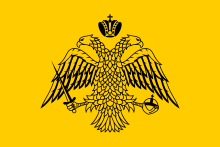
Culture[]
The icon of the Mother of God called Axion estin, which usually sits behind the altar of the Protaton church of Karyès, as hegumene of all the Holy Mountain, is occasionally shown in large Greek cities where it receives honors comparable to those reserved for a head of state.
Since 1990, the Monastic Republic of Mount Athos has experienced a spiritual renewal thanks to a regular influx of young people, often graduates and from the former Soviet bloc, which has dramatically increased the number of monks and novices. Initially, eleven monasteries followed the same rule of Saint Sabbas, common to Eastern Orthodox monasticism (cenobitic monasteries); in nine others the monks each formulated and followed their own rules (idiorrythmic monasteries). Between 1970 and 1990, all the monasteries finally adopted a cenobitic community system.
The access of "any female creature", including women, is strictly forbidden, so as not to tempt the monks. Exceptions include cats to control rodents, and hens for eggs, the latter being used both for food and to make egg tempera, the favored medium for icon painting.
Monastic life[]
The monasteries of Mount Athos have a history of opposing ecumenism, or movements towards reconciliation between the Orthodox Church of Constantinople and the Roman Catholic Church. The Esphigmenou monastery is particularly outspoken in this respect, having raised black flags to protest against the meeting of Patriarch Athenagoras I of Constantinople and Pope Paul VI in 1972. Esphigmenou was subsequently expelled from the representative bodies of the Athonite Community. The conflict escalated in 2002 with Patriarch Bartholomew I of Constantinople declaring the monks of Esphigmenou an illegal brotherhood and ordering their eviction; the monks refused to be evicted, and the Patriarch ordered a new brotherhood to replace them.
The monasteries also have opposed ecumenism between the Orthodox Church of Constantinople and Oriental Orthodox Churches. Following the First[5] and Second[6] Agreed Statements published by the in 1989 and 1990 respectively, and the subsequent Proposals for Lifting Anathemas[7] in 1993, a committee formed by the monasteries published a responding memorandum expressing their condemnation of what they percieved to be an imminent false union with "the Non-Chalcedonians".[8]
After reaching a low point of just 1,145 mainly elderly monks in 1971, the monasteries have been undergoing a steady and sustained renewal. By the year 2000, the monastic population had reached 1,610, with all 20 monasteries and their associated sketes receiving an infusion of mainly young, well-educated monks. In 2009, the population stood at nearly 2,000.[9] Many younger monks possess university education and advanced skills that allow them to work on the cataloging and restoration of the Mountain's vast repository of manuscripts, vestments, icons, liturgical objects and other works of art, most of which remain unknown to the public because of their sheer volume. Projected to take several decades to complete, this restorative and archival work is funded by UNESCO and the EU, and aided by many academic institutions. The history of the modern revival of monastic life on Mount Athos and its entry into the technological world of the twenty-first century has been chronicled in Graham Speake's book, now in its second edition, Mount Athos. Renewal in Paradise.[10]
Administration and organization[]
According to the constitution of Greece,[11] the Republic (the "Monastic State of Agion Oros") is, "following ancient privilege", "a self-governed part of the Greek State, whose sovereignty thereon shall remain intact", and consists of 20 main monasteries which constitute the Sacred Community, and the capital town and administrative centre, Karyes, also home to a as the representative of the Greek state. The governor is an executive appointee. The status of the Republic was expressly described and ratified upon the admission of Greece to the European Community.
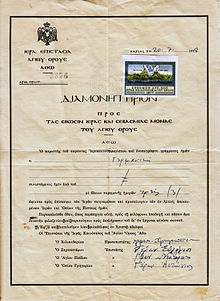
The Republic is under the direct jurisdiction of the Ecumenical Patriarch of Constantinople Bartholomew I.
Administration[]
The Republic is governed by the "Sacred Community" (Ιερά Κοινότητα – Iera Koinotēta). It consists of representatives from the monasteries. There is a four-man executive committee, the "Sacred Administration" (Ιερά Επιστασία – Iera Epistasia), with the protos (Πρώτος) being its head. The current Protos or "Protepistátēs" is the Elder Symeon Dionysiates.
Civil authorities are represented by the , appointed by the Greek Ministry of Foreign Affairs. He supervises the function of the institutions and the public order. The current Civil Governor is Athanasios Martinos.
Each of the 20 monasteries is administered by an archimandrite elected by the monks for life. The Convention of the brotherhood (Γεροντία) is the legislative body. Each of the other establishments (sketes, cells, huts, retreats, and hermitages) is a dependency of one of the 20 monasteries and is assigned to the monks by a document called omologon (ομόλογον).
Monks[]
All persons leading a monastic life in the Republic receive Greek citizenship upon admission as novices or monks. Laymen can visit the Republic, but they need a special permit known as a diamonētērion (διαμονητήριον)
In 17 of the monasteries, the monks are predominantly ethnic Greek. The Helandariou Monastery is Serbian, the Zografou Monastery is Bulgarian and the Agiou Panteleimonos monastery is Russian.
Most of the sketes are also predominantly ethnic Greek; however, two sketes are Romanian. They are the coenobitic "Skētē Timiou Prodromou" (under Megistis Lavras Monastery) and the idiorrhythmic "Skētē Agiou Dēmētriou tou Lakkou", also called "Lakkoskētē" (under to the Agiou Pavlou monastery). A third skete is Russian, "Skētē Bogoroditsa" (under the Agiou Panteleimonos monastery).
The Greek language is commonly used in all the Greek monasteries, but in some monasteries there are other languages in use: in Agiou Panteleimonos, Russian (67 monks in 2011); in Helandariou Monastery, Serbian (58); in Zographou Monastery and Skiti Bogoroditsa, Bulgarian (32); and in Timiou Prodromou and Lakkoskiti, Romanian (64). Today, many of the Greek monks also speak foreign languages. Since there are monks from many nations in Athos, they naturally also speak their own native languages.
History[]
Early history[]
The Republic originated under the Byzantine Empire. It was described as a "self-ruled monastic state" in a chrysobull parchment signed and sealed by Emperor Ioannis Tzimisces in 972.[citation needed] This document is preserved in the House of the Holy Administration in Karyes.
The self-rule of the Republic was reaffirmed in 1095 by Emperor Alexios I Komnenos.
Modern founding of the Republic[]

The Republic, according to the Decree passed by the Holy Community on 3 October 1913 and according to the international treaties of London (1913), Bucharest (1913), Neuilly (1919), Sèvres (1920) and Lausanne (1923), is considered part of the Greek state.
The Decree, "made in the presence of the Holy Icon of Axion Estin", stated that the Holy Community recognised the Kings of Greece as the lawful sovereigns and "successors on the Mountain" of the "Emperors who built" the monasteries and declared its territory as belonging to the then Kingdom of Greece.
World War II[]
During the 1941 German invasion of Greece, Time magazine described a bombing attack near the Republic, "The Stukas swooped across the Aegean skies like dark, dreadful birds, but they dropped no bombs on the monks of Mount Athos".[12]
During the German occupation of Greece, the Epistassia formally asked Adolf Hitler to place the Republic under his personal protection. Hitler agreed and received the title "High Protector of the Holy Mountain" (German: Hoher Protektor des heiligen Berges) from the monks. The Republic was able to avoid significant damage during the war.[13][better source needed]
Post-war[]
After the war, a Special Double Assembly passed the constitutional charter of the Republic, which was then ratified by the Greek Parliament.
In 2018, the Republic became an issue in Greece-Russia relations when the Greek government denied entry to Russian clerics headed for the Republic. The media reported allegations that the Russian Federation was using the Republic as a base for intelligence operations in Greece.[14]
Relations with Russia worsened in October 2018 after the Russian Orthodox Church banned its adherents from visiting sites controlled by Patriarch Bartholomew I of Constantinople, including the Republic.[15]
Prohibition on entry of women[]
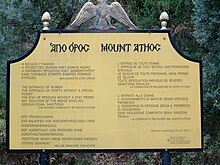
The Republic bans women and female animals from entry in what is called an avaton (Άβατον). This intended to make living in celibacy easier for men who have chosen to do so.[16] Monks feel that the presence of women alters the social dynamics of the community and therefore slows their path towards spiritual enlightenment.
The ban was officially proclaimed by several emperors, including Constantine Monomachos, in a chrysobull of 1046.[17]
In the 14th century, Serbian Emperor Dušan the Mighty brought his wife, Helena of Bulgaria, to the Republic to protect her from the plague. She avoided breaking the ban by not touching the ground for her entire visit, being constantly carried in a hand carriage.[18]
Maryse Choisy entered the Republic in the 1920s disguised as a sailor. She later wrote about her escapade in Un mois chez les hommes ("A Month with Men").[19]
In the 1930s, Aliki Diplarakou dressed as a man and snuck into the Republic. Her stunt was discussed in a 13 July 1953 Time magazine article entitled "The Climax of Sin".[20]
In 1953, Cora Miller, an American Fulbright Program teacher, landed briefly along with two other women, stirring up a controversy among the local monks.[21]
A 2003 resolution of the European Parliament requested the lifting of the ban for violating "the universally recognised principle of gender equality".[22]
On 26 May 2008, five Moldovans illegally entered Greece by way of Turkey, ending up in the Republic. Four of these migrants were women. The monks forgave them for trespassing and informed them that the area was forbidden to females.[23]
Female domestic animals such as cows or sheep are also barred, except for female cats.[24]
Status in the European Union[]
As part of an EU member state, Mount Athos is part of the European Union and, for the most part, subject to EU law. While outside the EU's Value Added Tax area, Mount Athos is within the Schengen Area. A declaration attached to Greece's accession treaty to the Schengen Agreement states that Mount Athos's "special status" should be taken into account in the application of the Schengen rules.[25] The monks strongly objected to Greece joining the Schengen Area based on fears that the EU would be able to end the centuries-old prohibition on the admittance of women.[26] The prohibition is unchanged and a special permit is required to enter the peninsula. The monks were also concerned that the agreement could affect their traditional right to offer sanctuary to people from Orthodox countries such as Russia.[26] Such monks do nowadays need a Greek visa and permission to stay, even if that is given generously by the Greek ministry, based on requests from Athos.[27]
Monastic life[]
Today the 20 monasteries of Mount Athos are the dominant holy institutions for both spiritual and administrative purposes, consolidated by the Constitutional Chart of the Holy Mountain. From the beginning of Mount Athos' history, monks have lived in lodgings of different size and construction quality. All these monastic lodging types still exist today, denoted as seats (καθίσματα), cells (κελλιά), huts (καλύβες), retreats (ησυχαστήρια), hermitages (ερημιτήρια), caves (σπήλαια), and sketai (σκήτες), all of which known under the general term "dependencies" (εξαρτήματα) of the Holy Monasteries. The term "cells" can be used more specifically, comprising all the above but sketae. Following these terms, the three different kind of institutions in Mount Athos are monasteries, cells, and sketae.
Monasteries[]

A pilgrim/visitor to a monastery who is accommodated in the guest-house (αρχονταρίκι) can have a taste of the monastic life in it by following its daily schedule: praying (services in church or in private), common dining, working (according to the duties of each monk) and rest. During religious celebrations, long vigils are typically held and the daily program is dramatically altered. The gate of the monastery closes by sunset and opens again by sunrise.
Cells[]
A cell is a house with a small church where 1–3 monks live under the supervision of a monastery. Some of the cells resemble farmhouses and others are simple huts, while others have the refinement of Byzantine tradition or Russian architecture of the past century. Usually, each cell possesses a piece of land for agricultural or other use. Each cell has to organize some activities for income.
Besides the traditional occupations (agriculture, fishing, woodcarving, spirit distillation, iconography, tailoring, book binding etc.) new occupations have been taken up, such as taxi driving, couriering, car repairing and computer services.[citation needed] The monk(s) living in a cell, having to take care of all daily chores, create their own schedules. Most of the cells have very limited or no capacity for visitors.
Sketes[]

Small communities of neighbouring cells have developed since the beginning of monastic life in the Republic, some of which using the word "skete" (σκήτη) meaning "monastic settlement" or "lavra" (λαύρα) meaning "monastic congregation". The word "skete" is of Coptic origin and in its original form is a placename of a location in the Egyptian desert.[28] It is here in the Egyptian desert that monasticism made its first steps.
The unknown author of the "History of the Egyptian Monks" (Historia Monachorum in Aegypto), perhaps Flavius Rufinus, visited the area at the end of the fourth century. He tells us: "Then we came to Nitria, the best-known of all monasteries of Egypt, about forty miles [60 km] from Alexandria; it takes its name from a nearby town where Nitre is collected... In this place there are about fifty dwellings, or not many less, set near together and under one father. In some of them, there are many living together, in others a few and in some there are brothers who live alone. Though they are divided by their dwellings they remain bound together and inseparable in faith and love". Here is described the main idea of a "skete", or communal monastic community, a blend of the eremitic way and the coenobitic way of monasticism, with all 3 coexisting until today.
In 1680, the ex-patriarch Dionysios III Vardalis built in the Saint Anne skete of the Holy Mountain a large central church to accommodate all the monks of the area. In 1689, an internal regulatory text was constituted by the monks and ratified first by the Monastery of Megisti Lavra followed by the patriarch Dionysios V Haritonidis; it was later ratified again by patriarch Cyril V, who contributed to its evolution. Since then, more sketes had followed suit, and gradually the term "skete" (within the Holy Mountain) came to be used only for the monastic settlements having an internal rule ratified by the Patriarchate.
Later on, some cells came to attract many monks, expand their buildings and start to function in the coenobitic way of the monasteries. Since the number of monasteries in Mount Athos was restricted to 20, a new term was introduced: the coenobitic skete (κοινόβιος σκήτη), while a skete of the traditional form was named idiorhythmic skete (ιδιόρρυθμος σκήτη) in order to underline the difference.
The first ones, both in architecture and lifestyle, followed the typical model of a monastery, that of a community living together, sharing and distributing work, and praying together daily. In contrast, the idiorrhythmic community (intermediary between the coenobitic community and the seclusion of a hermit) resembles a hamlet, and the daily life there is much like that of a cell. Yet, there are also some community duties. Near the centre of the settlement is the central church called Kyriakon (Κυριακόν, that could be translated "for Sunday"), where the whole brotherhood meets for the Divine Liturgy service on Sundays and on greater feasts. Sketes also usually have an administration house, a refectory for common celebrations, a cemetery, a library, storehouses and a guesthouse.
Culture and life in the Athonite Republic[]
Art and literary treasures[]
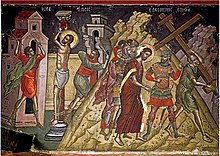

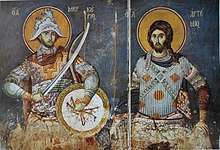
The Athonite monasteries possess huge deposits of invaluable medieval art treasures, including icons, liturgical vestments and objects (crosses, chalices), codices and other Christian texts, imperial chrysobulls, holy relics etc. However, the monks consider them for their religious function only, not as "treasures" and most are in regular use for their original purpose. Until recently, no organized study or archiving had been carried out, but an EU-funded effort to catalogue, protect and restore them has been underway since the late 1980s. Their sheer number is such that it is estimated to take several decades before the work is completed.
Among the most ancient and priceless codices at Mount Athos are the Codex Athous Lavrensis and the Codex Athous Dionysiou.
Date and timekeeping[]
The Julian calendar, which currently has a difference of 13 days from the Gregorian calendar, is still used in the Republic.
In 1923, a synod in Constantinople adopted the Revised Julian calendar.[note 1] All but one of the monasteries refused to change over to the revised calendar. The Patriarch finally gave in and requested that the one monastery using the Revised Julian calendar revert to the old Julian calendar.
The Republic also uses Byzantine time, in which the day commences at sunset as does the liturgical day[note 2] and not at midnight as in the reckoning of civil time. The difference between civil and Byzantine time varies according to the season.
Because the time interval from sundown to sundown is not constant, clocks showing the Byzantine time require continual manual readjusting which in current practice is done weekly, on Saturday, if the sky is clear; where the summit of Athos is visible, 12:00 is set when the last rays of sunlight cease to shine on the tip.
Some monasteries also have a clock showing civil time since boat schedules run thereon (and on the civil calendar) as well as for pilgrims who may be disoriented by Byzantine time reckoning.
List of religious institutions[]
Twenty monasteries[]
The sovereign monasteries, in the order of their place in the Athonite hierarchy:
| Great Lavra monastery | Vatopedi monastery | Iviron monastery | Helandariou monastery | Dionysiou monastery |
|---|---|---|---|---|
| Μεγίστη Λαύρα | Βατοπέδι | Ιβήρων ივერთა მონასტერი (Georgian) |
Χιλανδαρίου Хиландар (Serbian) |
Διονυσίου |
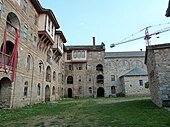
|

|

|

|
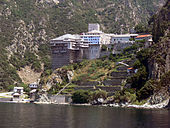
|
| Koutloumousiou monastery | Pantokratoros monastery | Xeropotamou monastery | Zografou monastery | Docheiariou monastery |
| Κουτλουμούσι | Παντοκράτορος | Ξηροποτάμου | Ζωγράφου Зограф (Bulgarian) |
Δοχειαρίου |

|
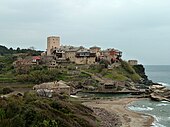
|

|
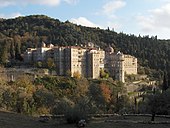
|
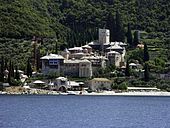
|
| Karakalou monastery | Filotheou monastery | Simonos Petras monastery | Agiou Pavlou monastery Mănăstirea Sfântul Pavel (Romanian) |
Stavronikita monastery |
| Καρακάλλου | Φιλοθέου | Σίμωνος Πέτρα | Αγίου Παύλου | Σταυρονικήτα |

|
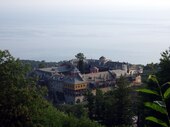
|
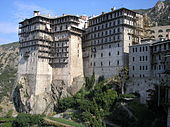
|

|
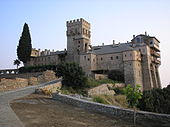
|
| Xenophontos monastery | Osiou Grigoriou monastery | Esphigmenou monastery | Agiou Panteleimonos monastery
Пантелеймонов (Russian) |
Konstamonitou monastery |
| Ξενοφώντος | Οσίου Γρηγορίου | Εσφιγμένου | Αγίου Παντελεήμονος | Κωνσταμονίτου |

|

|
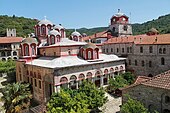
|
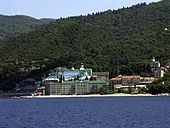
|
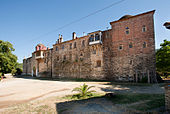
|
Twelve sketes[]
A skete is a community of Christian hermits following a monastic rule, allowing them to worship in comparative solitude, while also affording them a level of mutual practical support and security. There are two kinds of sketes in Mount Athos. A coenobitic skete follows the style of monasteries. An idiorrhythmic skete follows the style of a small village: it has a common area of worship (a church), with individual hermitages or small houses around it, each one for a small number of occupants. There are twelve official sketes on Mount Athos.
| Skete | Type | Monastery | Alternative names / notes |
|---|---|---|---|
| Agias Annas
Αγίας Άννας |
Idiorrhythmic | Megistis Lavras | (= Saint Anne)
Agiánna |
| Agias Triados or
Αγίας Τριάδος ή Καυσοκαλυβίων |
Idiorrhythmic | Megistis Lavras | (= Holy Trinity)
Kafsokalývia (="burned huts") |
| Timiou Prodromou
Τιμίου Προδρόμου |
Coenobitic | Megistis Lavras | (= Holy Fore-runner, i.e. St John the Baptist)
Prodromu, Sfântul Ioan Botezătorul – Romanian |
| Agiou Andrea
Αγίου Ανδρέα |
Coenobitic | Vatopediou | (= Saint Andrew)
Also known as Saray (Σαράι) |
|
Αγίου Δημητρίου |
Idiorrhythmic | Vatopediou | (= Saint Demetrius)
Vatopediní |
|
Τιμίου Προδρόμου Ιβήρων |
Idiorrhythmic | Iviron | (= Holy Forerunner, i.e. St John the Baptist)
Ivirítiki |
| Agiou Panteleimonos
Αγίου Παντελεήμονος |
Idiorrhythmic | Koutloumousiou | (= Saint Panteleimon/Pantaleon)
Koutloumousianí |
| Profiti Ilia
Προφήτη Ηλία |
Coenobitic | Pantokratoros | (= Prophet Elijah) |
| Theotokou or Nea Skiti
Θεοτόκου ή Νέα Σκήτη |
Idiorrhythmic | Agiou Pavlou | (=Of God-Bearer or New Skete) |
| Agiou Dimitriou tou Lakkou or Lakkoskiti
Αγίου Δημητρίου του Λάκκου ή Λακκοσκήτη |
Idiorrhythmic | Agiou Pavlou | (= Saint Demetrius of the Ravine or Ravine-Skete)
Lacu, Sfântul Dumitru – Romanian |
| Evangelismou tis Theotokou
Ευαγγελισμού της Θεοτόκου |
Idiorrhythmic | Xenophontos | (= Annunciation of Theotokos)
Xenofontiní |
| Bogoroditsa
Βογορόδιτσα |
Coenobitic | Agiou Panteleimonos | (= Theotokos, God-Bearer)
Богородица – Bulgarian |
Main settlements[]
- Karyes
- Dafni
Friends organization[]
The Friends of Mount Athos (FoMA) is a society formed in 1990 by people who shared a common interest for the monasteries of Mount Athos, and a registered charity in the U.K. (Registered Charity No. 1047287). Timothy Ware, Metropolitan Kallistos of Diokleia, is the President of the society. Among its members are the late Prince Philip, Duke of Edinburgh and Charles, Prince of Wales, Heir Apparent to the British throne, who is the royal patron of the society.[29] Although founded in the U.K., the society has an extensive international membership, including a large membership in the Americas.
The objective of the society, as stated on its official web page, is stated to be: "the advancement of education of the public in the study and knowledge of the history, culture, arts, architecture, natural history, and literature of the Orthodox monasteries of Mount Athos and the promotion of the religious and other charitable work of the Holy Community and monasteries of Mount Athos." To that end, the society works to advance education by studying and providing information on the history, culture, arts, architecture, natural history, and literature of Mount Athos. To achieve this, it produces publications, arranges lectures, and organizes conferences and exhibitions devoted to Athonite themes.
The society also supports and promotes the religious and other charitable work of the monasteries and their dependencies as well as other religious communities with links to the Holy Mountain. FoMA acts as a group of concerned friends and supporters, providing assistance where possible, in consultation with the monastic authorities. Appeals may be launched from time to time if funds are needed for specific purposes, but the assistance mainly takes the form of expertise, liaison, or equipment needed by the monks. The society's American membership founded in 2017 a parallel charitable foundation, The Mount Athos Foundation of America.
As a service to the monasteries and to pilgrims, the society clears and maintains the ancient footpaths of Mount Athos, with many of the stone-paved (Kalderimi) paths dating back to the Byzantine era. It also provides on its website detailed footpath descriptions with GPS tracks, and a regularly updated report on the condition of the paths. FoMA member and cartographer, Peter Howorth of Christchurch, New Zealand, working with the society's footpath team, has recently published a new Pilgrim Map[30] which incorporates modern mapping technology with study of early maps of Mount Athos.
Among the society's publications are its annual bulletin (Friends of Mount Athos Annual Report) offering articles, book reviews and other features related to Mount Athos. Past issues are available from the society's web site. It also publishes A Pilgrim's Guide to Mount Athos in both printed and continuously updated digital forms,[30] as well as a yearly directory of members.
See also[]
Notes[]
References[]
- ^ "Η αλλαγή Ιεράς Επιστασίας στο Άγιο Όρος- Η Αγιορείτικη τελετή που έχει παλαιές ρίζες- Πλούσιο Φωτογραφικό υλικό". June 14, 2019.
- ^ "The new Civil Governor of Mount Athos at the Ecumenical Patriarch". September 5, 2019.
- ^ 2011 Greek census: "Απογραφή Π��ηθυσμού - Κατοικιών 2011. ΜΟΝΙΜΟΣ Πληθυσμός". Hellenic Statistical Authority. (in Greek)
- ^ Manson, Megan (11 Oct 2017). "UNESCO: Putting religious privilege above gender equality". secularism.co.uk. National Secular Society. Retrieved 11 Apr 2021.
- ^ Joint Commission Of The Theological Dialogue Between The Orthodox Church And The Oriental Orthodox Churches. (1989). First Agreed Statement. Wadi-El-Natroun, Egypt: Anba Bishoy Monastery.
- ^ Joint Commission Of The Theological Dialogue Between The Orthodox Church And The Oriental Orthodox Churches. (1990). Second Agreed Statement. Chambesy, Geneva, Switzerland:Orthodox Center of the Ecumenical Patriarchate.
- ^ Joint Commission Of The Theological Dialogue Between The Orthodox Church And The Oriental Orthodox Churches. (1993). Second Agreed Statement. Chambesy Geneva, Switzerland: Orthodox Center of the Ecumenical Patriarchate.
- ^ Committee from the Sacred Community of the Holy Mountain Athos. (1994). Concerning the Dialogue of the Orthodox with the Non-Chalcedonians. Mount Athos, Greece: The Sacred Community of Mount Athos.
- ^ Robert Draper, "Mount Athos" Archived 11 August 2011 at the Wayback Machine, National Geographic magazine, December 2009
- ^ Graham Speake (2014). Mount Athos. Renewal in Paradise. Denise Harvey. ISBN 978-960-7120-34-2..
- ^ Article 105 of the Constitution of Greece Archived 11 March 2007 at the Wayback Machine – The regime of Mount Athos.
- ^ "MOUNT ATHOS: Failing Light". Time. 28 April 1941. Archived from the original on January 28, 2012. Retrieved 15 September 2011.
- ^ "The Hitler icon: How Mount Athos honored the Führer – Alan Nothnagle". Open Salon. 27 October 2010. Archived from the original on 2 February 2013. Retrieved 15 September 2011.
- ^ Smith, Helena (11 August 2018). "Greece accuses Russia of bribery and meddling in its affairs". The Guardian. Retrieved 11 August 2018.
- ^ MacFarquhar, Neil (20 October 2018). "Mount Athos, a Male-Only Holy Retreat, Is Ruffled by Tourists and Russia". The New York Times. Retrieved 26 October 2018.
- ^ Mount Athos Archived 28 April 2016 at the Wayback Machine, an IFPA (Independent Film Production Associates Limited) – Cinevideo co-production in association with Channel 4 Television, London. 1985.
- ^ Schwimmer, Walter. "Human Rights Aspects of Current Problems of Mount Athos". Report to international conference: "The Holy Mount Athos – the unique spiritual and cultural heritage of modern world" (Weimar, Germany) 23–26 June 2012. Archived from the original on 23 March 2016. Retrieved 7 September 2014.
- ^ C 2006, ABC Design & Communication (12 November 1935). "VAGABOND – the first and only monthly magazine in English". Vagabond-bg.com. Archived from the original on 9 January 2009. Retrieved 5 May 2009.
- ^ Sack, John (1959). Report from Practically Nowhere. New York: Curtis Publishing Company. pp. 148–149.
- ^ The Climax of Sin Archived 14 June 2006 at the Wayback Machine, Time Magazine, 1953
- ^ "Women Invade Athos Despite 1,000-Year Ban". The New York Times. 26 April 1953. Retrieved 15 July 2011.
- ^ "European Parliament resolution on the situation concerning basic rights in the European Union". European Parliament. 15 January 2003. pp. Equality between men and women § 98. Retrieved 6 September 2008.
- ^ "Women breach all-male Greek site". BBC. 27 May 2008.
- ^ Why, Who, What (27 May 2016). "Why are women banned from Mount Athos?". BBC.
- ^ Joint Declaration No. 5 attached to the Final Act of the accession treaty.
- ^ Jump up to: a b "Monks see Schengen as Satan's work". BBC News. 16 June 1998.
- ^ Greece Archived 18 October 2014 at the Wayback Machine (Center for International Economic Cooperation)
- ^ Variant names: Skiathis – Sketis – Skithis – Skitis – Skete – Oros Nitrias (Nitria) – Wadi el-Natrun – sites including Deir el-Surian (Deir el-Syriani), the monastery of Maria Deipara, Kellia, the monastery Deir Abu Maqar, Qaret el-Dahr, Quçur el-Rubaiyat according to the on-line dictionary "Trismegistos" <http://www.trismegistos.org/geo/detail.php?tm=3375 Archived 26 February 2012 at the Wayback Machine>
- ^ "Prince visits 'monastic republic'". BBC. 12 May 2004.
- ^ Jump up to: a b "The Mount Athos Pilgrim Map". The Friends of Mount Athos. 2016. Archived from the original on 23 January 2018. Announcement of the Pilgrim Map, with link to the cartographer's website.
External links[]
- Subdivisions of Greece
- Ecumenical Patriarchate of Constantinople
- Theocracies
- Eastern Orthodoxy in Greece
- Mount Athos
- Men's religious organizations
- Autonomous republics
- Special territories of the European Union